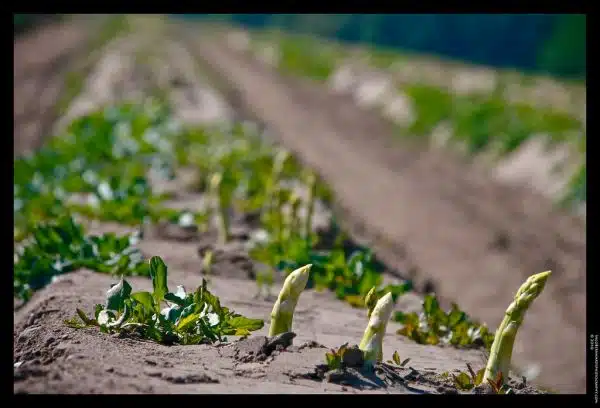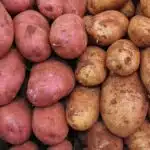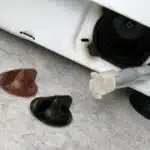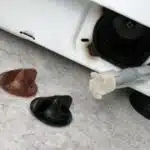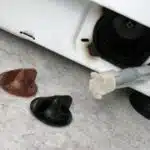Asparagus is a highly sought-after vegetable that has been a staple in culinary dishes for centuries. Harvesting asparagus can be a daunting task, but it is essential to ensure that the plant continues to produce high-quality spears year after year. As an asparagus harvesting expert, I have observed that many gardeners are unsure of how and when to harvest their asparagus plants correctly, which can lead to diminished yields and lower quality produce.
Timing is everything when it comes to harvesting asparagus. The ideal time for harvesting depends on several factors, including the age of the plant, the climate of the region, and the variety of asparagus being grown. It is crucial to know when to begin harvesting because if done too early or too late, it can negatively impact future yields of the plant. In this article, I will share my insights into how and when to harvest asparagus successfully so that you can serve your family and guests with deliciously fresh and healthy spears from your own garden.
Understanding The Asparagus Plant
The asparagus plant is a perennial crop that has been cultivated for centuries because of its nutritional value and unique taste. Before diving into the intricacies of harvesting asparagus, it is essential to have a basic understanding of the plant’s anatomy and soil pH requirements.
The roots of the asparagus plant are fleshy and widespread, with a crown at the top that produces shoots. The spears that we harvest are actually the young shoots that emerge from the crown in springtime. These spears grow rapidly, often reaching 6-8 inches in length within a day or two. If not harvested on time, they will eventually mature into tall ferns that produce small berries.
Understanding soil pH is crucial when growing asparagus. This vegetable thrives in well-draining soils with a pH level between 6.0 and 7.5. It is important to note that asparagus plants can grow in slightly acidic soils, but they tend to be more susceptible to diseases and pests. On the other hand, alkaline soils can lead to nutrient deficiencies and slow growth rates. Therefore, before planting asparagus, ensure that you test your soil’s pH level and adjust it accordingly to create an optimal environment for your crop.
With an understanding of asparagus’ anatomy and ideal soil conditions established, it’s time to move on to preparing for harvest season by assessing plant maturity and knowing when to start harvesting spears.
Preparing For Harvest Season
To ensure a successful asparagus harvest, it is crucial to properly prepare your asparagus beds. Begin by removing any weeds or debris from the bed, being careful not to disturb the asparagus roots. Next, add a layer of compost or well-rotted manure to the bed and work it into the soil. This will provide necessary nutrients for healthy plant growth and development.
Maintaining healthy asparagus plants is also key in preparing for harvest season. Regularly monitor your plants for pests and diseases, and take appropriate measures if needed. Asparagus plants require consistent moisture throughout their growing season, so be sure to water them regularly, especially during dry spells.
In addition to maintaining optimal growing conditions for your asparagus plants, it’s important to give them time to establish themselves before harvesting. Avoid harvesting any spears during the first year of growth, and only harvest lightly during the second year. By doing so, you will allow the plants to build up energy reserves in their roots for future seasons of bountiful harvests.
- Provide proper drainage in asparagus beds
- Apply fertilizer regularly
- Keep soil pH between 6.5 and 7
With these preparations in place, you’ll be well on your way to a successful asparagus harvest season. The next step is identifying the ideal harvest time – an essential aspect of maximizing both quality and quantity of your yield.
Identifying The Ideal Harvest Time
Preparing for harvest season is an essential part of the asparagus growing process. Asparagus harvesting experts know that identifying the ideal time to harvest is crucial to ensure a bountiful yield. There are several factors affecting harvest time, and asparagus spear size is one of them.
The ideal harvest time is when the asparagus spears are 6-10 inches tall and about as thick as your index finger. However, this can vary depending on the temperature and weather conditions in your area. Growing asparagus requires patience, but it’s worth it when you can enjoy fresh, delicious asparagus from your garden.
To determine if your asparagus is ready to harvest, look for signs such as tight tips and a deep green color. The tips should be tightly closed, indicating that they haven’t yet started to open up into fern-like branches. Additionally, make sure that the spears have a vibrant green color and don’t appear wilted or yellowish. Once you’ve identified these signs, it’s time to prepare for the harvest season and enjoy the fruits of your labor.
Signs That Your Asparagus Is Ready To Harvest
Stalk thickness is one of the key indicators of when asparagus is ready to harvest. The stalk should be at least pencil-thickness, and to test this, gently press the stalk between your thumb and index finger. Bud color is also an indication that the asparagus is ready to harvest; the buds should be a vibrant green. The tip of the spear should be firm and closed, and the stalk should be at least 8 inches in length before being harvested. If the stalk is too short, it isn’t yet ready to be harvested.
Stalk Thickness
Asparagus stalk thickness is one of the most important factors to consider when harvesting asparagus. The optimal soil conditions are essential for the growth and development of asparagus spears, which determine their thickness. Asparagus spears should be harvested when they reach a diameter of at least ½ inch but no more than 1 inch thick.
The thickness of the asparagus stalk indicates its age and maturity. Younger, thinner stalks are more tender and delicate, while thicker ones tend to be tougher and fibrous. It is best to harvest asparagus when it reaches an optimal size to ensure maximum flavor and tenderness. A good rule of thumb is that if the asparagus stalks start to split, then they have been left too long before harvesting.
Moreover, maintaining optimal soil conditions is crucial for growing healthy and flavorful asparagus crops. Adequate soil moisture levels, pH balance, and proper fertilization are key factors that significantly affect the size and quality of the asparagus spears. By keeping these factors in check, you can ensure that your asparagus crop grows healthy and produces deliciously plump spears that are perfect for harvesting at their peak thickness.
In conclusion, understanding the importance of asparagus stalk thickness is critical to achieving a successful harvest. It is vital to monitor your crop regularly to observe any signs indicating its readiness for harvesting, including its diameter. Additionally, ensuring optimal soil conditions throughout the growth phase will result in a bountiful harvest with perfectly sized and flavored asparagus spears.
Bud Color
As an asparagus harvesting expert, it is essential to know the signs that indicate when your crop is ready for harvest. One of these signs is the color of the asparagus buds. The bud color indicates the maturity of the asparagus plant and its readiness for harvest. Asparagus buds start off as tightly closed, pointed tips, and then slowly begin to elongate and open up. The color of the bud changes from a deep purple to a pale green or yellow when it reaches its optimal size.
Harvesting asparagus at its optimal maturity level ensures maximum flavor and nutritional value. To determine if your asparagus is ready for harvest, take note of the size and color of the bud. If your asparagus bud has reached a length of 6-8 inches and has turned a pale green or yellow hue, then it’s time to start harvesting. Gently snap off each spear at ground level with your fingers or use a sharp knife to cut them off just below the soil surface.
In conclusion, understanding the vital role that asparagus bud color plays in determining its readiness for harvest is crucial for any farmer looking to yield healthy crops with maximum flavor potential. With proper harvesting techniques, including monitoring the color and size of your asparagus’ buds, you can ensure that you’re harvesting at peak ripeness and producing plump spears that are sure to satisfy any palate.
How To Harvest Asparagus By Hand
Harvesting asparagus by hand is a delicate process that requires patience and precision to ensure maximum yield. The key to successful harvesting is timing, as the asparagus spears can grow up to 10 inches in a day. Typically, the harvesting season lasts for six to eight weeks in the spring, depending on the climate and location.
To harvest asparagus by hand, start by identifying the mature spears which are usually between 6-10 inches tall with tightly closed tips. Next, cut the spear at ground level with a sharp knife or scissors, being careful not to damage any surrounding spears or the roots of the plant. It’s important to harvest regularly every two days during peak season, as this encourages new growth and leads to higher yields.
Harvesting techniques play an essential role in optimizing yield. One method is called “snap-cutting,” where you bend the spear until it snaps at its natural breaking point. This technique requires practice but reduces waste and damage to surrounding spears. Another technique is “knife cutting” where you use a sharp knife or scissors to cut just below ground level. This method is more time-consuming but can result in higher quality spears suitable for sale.
- To ensure maximum yield, harvest every two days during peak season.
- Identify mature spears between 6-10 inches tall with tightly closed tips.
- Practice snap-cutting or knife cutting techniques for optimal results.
- Handle harvested asparagus with care and store it immediately for freshness.
With these techniques in mind, you’ll be able to harvest asparagus like a pro while maximizing your yield potential. In the next section, we’ll explore some of the tools needed for efficient harvesting!
Tools For Harvesting Asparagus
Imagine you are standing in a field of asparagus and you have your harvesting knife on hand. You have been waiting for this moment for months and now it is time to harvest the asparagus. But before you start, it is essential to have the necessary tools for harvesting asparagus. These tools include a sharp knife, gloves, a basket or bag, and knee pads.
Asparagus harvesting requires cutting the stem at ground level without damaging other spears that are emerging. To do this successfully and efficiently, having a sharp knife is crucial. Dull knives can cause damage to the plant and make harvesting more difficult. Gloves protect hands from thorns and scratches while handling the plants. A basket or bag can be used to collect harvested asparagus, while knee pads help prevent injuries while working on the ground.
For beginners who are interested in harvesting asparagus, it is essential to keep in mind some tips. First, it is important to know when to harvest asparagus; typically, this occurs when the plant reaches 7-9 inches tall. Second, it is better to harvest in the morning when temperatures are cooler because warm temperatures can reduce quality and shelf life of the harvested asparagus spears.
| Tool | Purpose | Recommended Brands |
|---|---|---|
| Harvesting Knife | Cut stems at ground level | Fiskars or Corona |
| Gloves | Protect hands from thorns and scratches | Atlas Nitrile or West County Gardener |
| Basket/Bag | Collect harvested asparagus | Picnic Time or Earthwise |
In summary, having essential tools like a sharp knife, gloves, basket/bag, and knee pads will make harvesting asparagus easier and efficient. For beginners interested in harvesting asparagus, knowing when to harvest and doing so during cooler temperatures will improve quality and shelf-life of the harvested spears. In the next section we will discuss harvesting asparagus with a machine, which can save time and effort.
Harvesting Asparagus With A Machine
- There are two main types of machines used to harvest asparagus: a platform harvester and a self-propelled harvester.
- Asparagus harvesting should begin when spears reach a diameter of 6-8mm and should be done at regular intervals to prevent over-maturity.
- Regular maintenance of the harvesting machine is essential to ensure optimal performance and harvesting efficiency.
- Asparagus spears should be harvested with a slow and steady movement to avoid damaging the spears or plants.
- Care should be taken to ensure that the machine is adjusted properly to match the height of the asparagus bed.
- The use of a machine to harvest asparagus requires a steady hand and a thorough understanding of the machine and the asparagus crop.
Machine Types
Asparagus harvesting has come a long way since the days of handpicking. With advancements in technology, different types of machines have been developed to make the process more efficient and cost-effective. There are two main types of asparagus harvesting machines: self-propelled and tractor-mounted.
Self-propelled machines are ideal for large-scale operations. They are equipped with a cutting blade that is adjusted to the height of the asparagus spears, allowing for precise cuts. The machine then uses conveyors to transport the cut asparagus into collection bins. Self-propelled machines can harvest up to 2 acres per day, making them a highly efficient option for commercial growers.
Tractor-mounted machines, on the other hand, are best suited for smaller farms or hobbyist growers. These machines attach to the back of a tractor and use a series of blades to cut the asparagus at ground level. They also have conveyors that transport the harvested asparagus into bins. Tractor-mounted machines can harvest up to half an acre per day and are more affordable than self-propelled options.
In conclusion, choosing the right type of asparagus harvesting machine is crucial for maximizing efficiency and reducing labor costs. Self-propelled machines are ideal for large-scale commercial operations while tractor-mounted machines are better suited for smaller farms or hobbyist growers. By selecting the appropriate machine type, farmers can ensure they get the most out of their harvest while minimizing labor expenses.
Harvest Timing
As an expert in asparagus harvesting, it is essential to understand the importance of harvest timing. Harvesting at the right time ensures that the asparagus spears are of optimal quality, flavor, and size. The timing of the harvest depends on the growth stage of the asparagus plant. Asparagus plants go through different growth stages, including dormancy, emergence, fern growth, and spear production.
The ideal time to start harvesting asparagus spears is when they reach a height of 6-8 inches. This typically occurs during late April or early May, depending on the climate and location. At this point, the spears are tender and flavorful, making them perfect for consumption. It is important not to wait too long to harvest asparagus because the spears can become woody and tough if left on the plant for too long.
Harvest timing is crucial when using an asparagus harvesting machine because it affects both efficiency and yield. With a self-propelled machine or tractor-mounted machine, farmers can quickly and efficiently harvest their crops at peak maturity. By doing so, they can maximize their yields while minimizing labor costs. Therefore, understanding harvest timing is critical for successful asparagus cultivation using a machine harvester.
Maintenance
Asparagus farming demands consistent maintenance practices to ensure that the crops remain healthy and productive. One such practice is weed control, which is essential in ensuring that the asparagus plants have access to adequate nutrients and moisture. Farmers can use mechanical or chemical methods to control weeds, although mechanical methods are preferred since they do not leave chemical residue on the soil. Moreover, farmers need to prepare the soil adequately before planting their asparagus crop. Soil preparation involves tilling the land and adding organic matter like manure or compost to improve its fertility.
Maintenance practices also play a significant role in ensuring that machine harvesters operate optimally during asparagus harvesting. Regular maintenance of harvesting machines ensures that they remain efficient throughout the harvesting period, which translates into increased yields and profitability for farmers. Proper machine maintenance entails cleaning after each use, inspecting parts regularly for damage or wear and tear, replacing worn-out parts promptly, and lubricating moving parts.
In conclusion, maintaining an asparagus farm is crucial for successful cultivation using a machine harvester. Weed control and proper soil preparation are vital in ensuring optimal growth of the crop while regular maintenance of harvesting machines ensures efficiency during harvesting periods. With these maintenance practices in place, farmers can maximize their yield while minimizing labor costs associated with asparagus farming.
Tips For Maximizing Your Yield
Harvesting asparagus is a delicate process that requires precision and care. Knowing when to harvest the asparagus is crucial in optimizing your yield. It is recommended to wait until the second or third year after planting before harvesting, as this allows the asparagus to establish strong roots and produce more spears.
Harvesting techniques vary depending on whether you are using manual or machine harvesting methods. Manual harvesting involves cutting the spears by hand just below the soil surface, while machine harvesting uses specialized equipment to cut and collect the spears automatically. Regardless of which method you choose, it is important to harvest regularly throughout the season to encourage new spear growth.
To maximize your yield, there are several tips you can follow. First, make sure to keep your asparagus bed weed-free and well-mulched to prevent competition for nutrients and water. Second, avoid over-harvesting by only removing about 25% of the spears at a time and allowing them to grow fully before cutting. Finally, consider using a foliar spray fertilizer during the growing season to promote healthy growth and increase yield.
Properly storing fresh asparagus is essential in preserving its quality and flavor. In order to do so, it is recommended to store freshly harvested asparagus in a cool place like a refrigerator with a damp paper towel wrapped around the bottom of each stem. This will help retain moisture and keep the spears crisp until ready for use. By implementing these techniques for harvesting and storage, you can enjoy fresh and delicious asparagus throughout the season while maximizing your yield.
Storing Fresh Asparagus
When it comes to asparagus, freshness is key. The best way to ensure that your asparagus stays fresh for a long time is by following the best practices for storing it. There are several preserving techniques that can be used to keep your asparagus in top condition.
One of the easiest ways to store asparagus is by placing it in a container with some water. This will help keep the asparagus hydrated and prevent it from drying out too quickly. Another option is to wrap the asparagus in a damp paper towel and then place it in a plastic bag. This will also help keep the asparagus hydrated while preventing excess moisture from building up.
It’s important to remember that asparagus should be stored in the refrigerator at all times. Keeping it at room temperature can cause it to spoil much more quickly than if it were kept cold. By following these simple storing guidelines, you’ll be able to enjoy fresh, delicious asparagus for weeks to come. In the subsequent section, we’ll explore how freezing asparagus for later use can be done easily and effectively.
Freezing Asparagus For Later Use
To preserve the freshness and flavor of asparagus for later use, freezing is a great option. Before freezing asparagus, it’s important to blanch it first. Blanching involves briefly boiling the asparagus to stop enzyme activity that causes loss of flavor and color. It also helps maintain the texture of the vegetable.
To blanch asparagus for freezing, start by washing the spears thoroughly in cold water. Cut off any tough ends or woody parts of the stems. Bring a large pot of water to boil and add a teaspoon of salt. Place the asparagus in the boiling water for 2-3 minutes until bright green and tender-crisp. Remove from boiling water and immediately place them in ice-cold water to stop further cooking.
Once blanched, you can freeze your asparagus in an airtight container or freezer bag for later use. Frozen asparagus can be used in various dishes such as stir-fries, soups, salads, omelets, quiches and more. You can even make delicious dips with them! Incorporating frozen asparagus into your meals is not only convenient but also a nutritious addition to your diet.
Looking for some recipe ideas? Try roasted asparagus with lemon zest or bacon-wrapped grilled asparagus for a delicious appetizer. For main dishes, try creamy risotto with steamed asparagus or grilled salmon with garlic buttered asparagus on the side. The possibilities are endless when it comes to this versatile vegetable! Now that you know how to freeze it properly and some tasty recipes to try out, let’s move on to preserving asparagus through canning for long-term storage.
Canning Asparagus For Long-Term Storage
Asparagus is a delicious and healthy vegetable that can be enjoyed year-round, but its short growing season means that it must be preserved for long-term storage. Canning is a great way to preserve asparagus, and with the right techniques and recipes, you can enjoy this vegetable even when it’s out of season.
When canning asparagus, it’s important to follow proper canning techniques to ensure the safety and quality of your food. First, choose fresh, firm asparagus stalks without any signs of damage or decay. Blanch them in boiling water for two minutes before placing them in jars with hot water and seasoning. Process the jars in a pressure canner according to your recipe’s instructions.
Once you’ve successfully canned your asparagus, you’ll have plenty of options for using it in dishes throughout the year. Recipes for asparagus soups, stews, salads, and side dishes abound online and in cookbooks. With a little creativity in the kitchen, you’ll be able to enjoy this delicious vegetable all year long!
To continue enjoying fresh asparagus from your own garden or local farmer’s market next season, avoiding common harvesting mistakes is crucial. With just a few simple adjustments to your harvesting technique, you can ensure a bountiful harvest each year without damaging your plants or compromising their yield.
Avoiding Common Harvesting Mistakes
- The timing for harvesting asparagus is essential for the optimal taste and nutrient content of the crop.
- The cutting technique used to harvest asparagus is important for preserving the health of the plant, as well as for the quality of the harvested product.
- Over-harvesting of asparagus can lead to weakened plants and reduced yields in subsequent years, as well as a decrease in the quality of the crop.
- Proper timing for harvesting asparagus is when the spears have reached a diameter of 0.5 inches and a length of 6-8 inches.
- The cut should be made at the soil line using a sharp knife or scissors to ensure that the crown of the plant is not damaged.
- To ensure a healthy and productive asparagus patch, it is important to only harvest the spears when they have reached the appropriate size and to only harvest a limited number of spears per plant.
Timing
As an expert in asparagus harvesting, it is crucial to understand the importance of timing. Harvesting asparagus at the right time is essential to ensure optimal growth and taste. Before discussing the timing of harvesting, it is vital to note that proper soil preparation is key to a successful harvest. Adequate soil preparation involves planting asparagus crowns in well-drained soil with a pH level between 6.5-7.5.
The ideal harvesting time for asparagus starts when the spears reach about eight inches tall and are approximately the thickness of a pinky finger. The first year after planting, avoid harvesting any spears; instead, let them grow into ferns to establish strong roots for future harvests. During the second year, harvest spears sparingly for only two weeks. In subsequent years, you can harvest spears for up to six weeks.
It is important to use proper harvesting techniques during this period to avoid damaging the plant’s crown or compromising future yields. When cutting spears from the ground, use a sharp knife or scissors and cut just below where they emerge from the soil line carefully. Cutting above this line will damage new growth and hamper future yields. By following these guidelines on timing and technique when harvesting asparagus, you can enjoy fresh and delicious homegrown produce for years to come without causing damage to your plant’s health or future productivity.
Cutting Techniques
As an expert in asparagus harvesting, I have seen many amateur gardeners make common mistakes when it comes to harvesting. One of these errors is using incorrect cutting techniques that can harm the plant’s crown and reduce future yields. Therefore, it is crucial to know the proper cutting technique for asparagus.
When cutting asparagus spears from the ground, one must use a sharp knife or scissors to ensure a clean cut. The blade’s sharpness is essential because a dull blade can damage the plant’s crown and leave ragged edges that are prone to infection. Additionally, the cutting depth should be just below where the spear emerges from the soil line, avoiding any contact with new growth.
By following these cutting techniques, you can avoid common mistakes when harvesting asparagus and ensure maximum productivity for years to come. Remember that proper soil preparation is also key to a successful harvest, so make sure to plant your crowns in well-drained soil with a pH level between 6.5-7.5. With these tips in mind, you can serve others by providing them with fresh and delicious homegrown produce without compromising your plant’s health or future yields.
Over-Harvesting
As an expert in asparagus harvesting, it is crucial to prevent over-harvesting to ensure the plant’s longevity and optimal yield. Over-harvesting occurs when multiple spears are cut from the same plant, leading to a weakened crown and reduced spear output. To avoid this mistake, one should manage asparagus growth carefully.
Managing asparagus growth involves understanding when to stop harvesting. Typically, the first year’s harvest should be light, with only a few spears harvested per plant. In the second year and beyond, you can increase your harvest but still leave some spears uncut so that they can grow tall and produce energy for future yields. As a general rule of thumb, one should stop harvesting when the spear diameter has decreased significantly or when the number of spears produced decreases substantially.
Preventing over-harvesting takes patience and discipline, but it pays off in the long run by ensuring a healthy plant and abundant future yields. By following proper cutting techniques and managing growth effectively, you can serve others by providing fresh and delicious homegrown produce while also preserving your plant’s health. Remember that asparagus is a perennial crop that requires careful attention throughout its lifecycle, so make sure to take good care of your plants to reap the benefits for years to come.
Troubleshooting Your Asparagus Crop
Common issues may arise during the growth and development of your asparagus crop that can affect its yield and quality. One of the most common issues that farmers encounter is pest infestation, particularly by asparagus beetles. These pests feed on the foliage and stems of the plant, causing defoliation and reduced productivity. To combat this issue, it is recommended to regularly inspect your plants for signs of beetle activity and to remove any adult beetles or larvae by hand or with insecticidal soap.
Another issue that may arise is inadequate soil fertility. Asparagus requires a well-draining soil that is rich in organic matter and nutrients such as nitrogen, phosphorus, and potassium. If your soil lacks these necessary components, it can cause stunted growth and poor yields. To address this issue, consider amending your soil with compost or other organic fertilizers before planting and applying additional fertilizer throughout the growing season as needed.
Lastly, improper watering practices can also lead to issues such as crown rot or drying out of the roots. It is important to maintain consistent moisture levels in the soil without overwatering or causing standing water around the plants. Consider using drip irrigation systems or watering deeply but infrequently to ensure proper hydration without drowning the roots.
Troubleshooting solutions for these common issues include regular monitoring of your plants for signs of distress, implementing preventative measures such as crop rotation or companion planting to reduce pest pressure, and ensuring proper maintenance of soil fertility and water management practices. By taking proactive steps to address these issues early on, you can help ensure a healthy and productive asparagus crop.
Transitioning into our next section about asparagus harvesting safety precautions, it is important to note that proper cultivation practices go hand in hand with safe harvesting methods.
Asparagus Harvesting Safety Precautions
If you have successfully troubleshooted any issues with your asparagus crop, it is now time to move on to the next step of the process: harvesting. As they say, “you reap what you sow,” and the same goes for asparagus. It is important to harvest at the right time to ensure optimal quality and quantity.
Harvesting efficiency should be a top priority when gathering your asparagus. This means that you should be able to collect as much produce as possible in a timely manner. One way to do this is by using proper tools such as a sharp knife or garden shears. Harvesting ergonomics are also important so that you do not strain your body while collecting your crop. This includes using good posture and taking breaks when necessary.
To ensure that you get the most out of your harvest, here are four tips:
- Harvest in the morning when temperatures are cooler.
- Cut or snap off spears that are at least 6-8 inches tall.
- Do not over-harvest from one plant; leave some spears behind for future growth.
- Stop harvesting once new spears start emerging smaller than pencil thickness.
By following these guidelines, you can enjoy a bountiful harvest of delicious and nutritious asparagus. So go ahead, gather your tools and get ready to enjoy the fruits of your labor!
Enjoying The Fruits Of Your Labor
Now that you have successfully harvested your asparagus, it’s time to enjoy the fruits of your labor. Before consuming the asparagus, it’s important to know some preserving methods to ensure its freshness and quality. One effective way is by storing the asparagus in a perforated plastic bag or wrapping them in a damp cloth before placing them in the refrigerator. This will help maintain their crispness and prevent wilting.
Aside from preserving methods, there are also various recipe ideas that you can try with your freshly harvested asparagus. Roasting is one of the most popular ways to cook asparagus. Simply toss the spears in olive oil, season with salt and pepper, and roast at 400°F for 12-15 minutes until tender. You can also blanch the asparagus and serve them with hollandaise sauce or add them to salads for a healthy boost.
Incorporating asparagus into your meals not only adds flavor but also comes with numerous health benefits. Asparagus is low in calories but high in fiber, vitamins, and minerals like folate, vitamin C, and potassium. So take advantage of this versatile vegetable and experiment with different recipes while reaping its nutritional benefits!
Conclusion
Asparagus harvesting requires careful planning and attention to detail. Understanding the biology of the asparagus plant, preparing for harvest season, and identifying the ideal harvest time are crucial steps in ensuring a successful crop. Once you have determined that your asparagus is ready to be harvested, it is important to use proper techniques to avoid damaging the delicate spears.
Harvesting mistakes can lead to reduced yields or even damage to the entire plant. While troubleshooting may be necessary in some cases, avoiding common mistakes such as cutting too close to the ground or harvesting too early can prevent many issues from arising. By following safety precautions and enjoying the fruits of your labor, you can experience the satisfaction of a job well done and a bountiful harvest of delicious asparagus.
In conclusion, harvesting asparagus requires patience, knowledge, and attention to detail. As an expert in this field, I recommend taking the time to understand your plants and preparing properly for harvest season. By using proper techniques and avoiding common mistakes, you can enjoy a successful crop year after year. Remember to always prioritize safety when working with sharp tools and enjoy the delicious results of your hard work!
Image Credits
- “Asparagus harvest May germany” by Spree2010 (featured)

